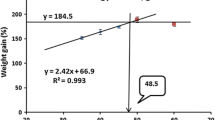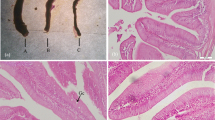Abstract
The aim of this study was to determine the optimal weaning protocols for rearing juvenile cuttlefish Sepia pharaonis, as well as to understand the feeding habits of cuttlefish and develop effective aqua-cultural practices. The effects of four experimental weaning protocols (i.e., food type, cuttlefish size, food ration (bw d−1) and feeding frequency (meals d−1)) on the growth, survival and muscle proximate composition of cuttlefish juvenile were studied in quintuplicate. The weaning period lasted 2 weeks. The results showed that cuttlefish fed with frozen white shrimp (Exopalaemon carinicauda) displayed a significantly higher survival, growth parameters, ingestion rate, food conversion rate, and muscle protein content when compared with the other prepared frozen foods. The larger individuals revealed better growth performance than smaller individuals, especially in terms of survival and specific growth rate, indicating that larger individuals were more receptive to frozen prey. Furthermore, size grading should be conducted to ensure better growth during weaning. As food rations increased, the survival, growth and muscle protein content of juveniles were promoted, whereas the most appropriate food ration for cuttlefish juvenile was 35% bw d−1. Similarly, higher feeding frequency could stimulate the appetite of animals reared on weaning, and enhance survival, growth, and protein deposition compared to low feeding frequency. These results suggest that the optimal feeding protocols of juvenile weaning is as follows: the ideal prepared food is frozen shrimp, the weight of juveniles should be 4.0 g (32 days old) or more, the food ration should be 35% (bw d−1), and the optimum feeding frequency is 4 meals day−1. This study offers a promising starting point to successfully breed this candidate aquaculture species.
Similar content being viewed by others
References
Anil, M. K., Andrews, J., and Unnikrishnan, C., 2005. Growth, behavior, and mating of pharaoh cuttlefish (Sepia pharaonis Ehrenberg) in captivity. The Israeli Journal of Aquaculture-Bamidgeh, 57: 25–31.
Association of Official Analytical Chemists (AOAC), 1995. Official Methods of Analysis of Official Analytical Chemists International. 16th edition. Association of Official Analytical Chemists, Arlington, VA, 1899pp.
Blanc, A., Pinczon du Sel, G., and Daguzan, J., 1998. Habitat and diet of early stages of Sepia officinalis L. (Cephalopoda) in Morbihan Bay, France. Journal of Molluscan Studies, 64: 263–274.
Bligh, E. G., and Dyer, W. J., 1959. A rapid method of total lipid extraction and purification. Canadian Journal of Biochemical Physiology, 37: 911–917.
Boucher-Rodoni, R., Boucaud-Camou, E., and Mangold, K., 1987. Feeding and digestion. In: Cephalopod Life Cycles, Vol. II. Boyle, P. R., ed., Academic Press, London, 85–108.
Buston, P., 2003. Size and growth modification in clownfish. Nature, 424: 145–146.
Castro, B. G., DiMarco, F. P., DeRusha, R., and Lee, P. G., 1993. The effects of surimi and pelleted diets on the laboratory survival, growth and feeding rate of the cuttlefish Sepia officinalis. Journal of Experimental Marine Biology and Ecology, 170: 241–252.
DeRusha, R. H., Forsythe, J. H., DiMarco, F. P., and Hanlon, R. T., 1989. Alternative diets for maintaining and rearing cephalopods in captivity. Laboratory Animal Science, 4: 306–312.
Domingues, P. M., Dimarco, P. F., Andrade, J. P., and Lee, P. G., 2005. Effect of artificial diets on growth, survival and condition of adult cuttlefish, Sepia officinalis, Linnaeus, 1758. Aquaculture International, 13: 423–440.
Domingues, P. M., Kingston, T., Sykes, A., and Andrade, J. P., 2001. Growth of young cuttlefish, Sepia officinalis (Linnaeus, 1758) at the upper end of the biological distribution temperature range. Aquaculture Research, 32: 923–930.
Domingues, P., Sykes, A., Sommerfield, A., Almansa, E., Lorenzo, A., and Andrade, P., 2004. Growth and survival of cuttlefish, Sepia officinalis (Linnaeus, 1758) of different ages fed crustaceans and fish. Effects of frozen and live prey. Aquaculture, 229: 239–254.
Domingues, P., Sykes, A., Sommerfield, A., and Andrade, P., 2003. The effects of feeding live or frozen prey on growth, survival and the life cycle of the cuttlefish, Sepia officinalis (Linnaeus, 1758). Aquaculture International, 11: 397–410.
Elofsson, U. O., Mayer, I., Damsgârd, B., and Winberg, S., 2000. Intermale competition in sexually mature arctic charr: Effects on brain monoamines, endocrine stress responses, sex hormone levels, and behavior. General and Comparative Endocrinology, 118: 450–460.
Fiorito, G., Affuso, A., Basil, J., Cole, A., de Girolamo, P., D’angelo, L., and Mark, F., 2015. Guidelines for the care and welfare of cephalopods in research-A consensus based on an initiative by CephRes, FELASA and the Boyd Group. Laboratory Animals, 49: 1–90.
Forsythe, J., Derusha, R., and Hanlon, R., 1994. Growth, reproduction and life span of Sepia officinalis (Cephalopoda: Mollusca) cultured through seven consecutive generations. Journal of Zoology, 233: 175–192.
Ghazvineh, L., Valinassab, T., Savari, A., and Ghobadiyan, F., 2012. Reproductive biology of the pharaoh cuttle Sepia pharaonis in the Persian Gulf. World Journal of Fish and Marine Sciences, 4: 313–319.
Iglesias, J., Fuentes, L., Sánchez, J., Otero, J. J., Moxica, C., and Lago, M. J., 2006. First feeding of Octopus vulgaris Cuvier, 1797 paralarvae using artemia: Effect of prey size, prey density and feeding frequency. Aquaculture, 261: 817–822.
Jiang, M. W., Peng, R. B., Wang, S. J., Peng, R. B., Han, Q. X., and Jiang, X. M., 2018. Growth performance and nutritional composition of Sepia pharaonis under artificial culturing conditions. Aquaculture Research, 49: 2788–2798.
Jiang, M. W., Peng, R., Peng, R. B., Han, Q. X., and Jiang, X. M., 2020. Effects of size dominance on the survival, growth and physiological activities of juvenile pharaoh cuttlefish (Sepia pharaonis). Journal of Experimental Marine Biology and Ecology, 525: 318–327.
Koueta, N., and Boucaud, E., 2003. Combined effects of photoperiod and feeding frequency on survival and growth of juvenile cuttlefish Sepia officinalis L. in experimental rearing. Journal of Experimental Marine Biology and Ecology, 296: 215–226.
Koueta, N., and Boucaud-Camou, E., 1999. Food intake and growth in reared early juvenile cuttlefish Sepia officinalis, l. (Mollusca Cephalopoda). Journal of Experimental Marine Biology and Ecology, 240: 93–109.
Koueta, N., Boucaud-Camou, E., and Noel, B., 2002. Effect of enriched natural diet on survival and growth of juvenile cuttlefish Sepia officinalis L. Aquaculture, 203: 293–310.
Le, K. X., Jiang, X. M., Peng, R. B., Luo, J., Tang, F., and Wang, C. L., 2014. Effects of four ecological factors on the growth and survival of Sepia pharaonis larvae. Journal of Biology, 31: 33–37 (in Chinese with English abstract).
Le, K. X., Wang, Y., Peng, R. B., Liang, J. J., Han, Q. X., and Jiang, X. M., 2016. Effects of starvation and re-feeding on survival rate, growth and digestive enzyme activities of juvenile Sepia pharaonis. Chinese Journal of Applied Ecology, 27: 2002–2008 (in Chinese with English abstract).
Lee, P. G., 1994. Nutrition of cephalopods: Fueling the system. Marine and Freshwater Behaviour and Physiology, 25: 35–51.
Lee, P. G., Forsythe, J. W., DiMarco, F. P., DeRusha, R. H., and Hanlon, R. T., 1991. Initial palatability and growth trials on pelleted diets for cephalopods. Bulletin of Marine Science, 49: 362–372.
Minton, J. W., Walsh, L. S., Lee, P. G., and Forsythe, J. W., 2001. First multi-generation culture of the tropical cuttlefish Sepia pharanois Ehrenberg, 1831. Aquaculture International, 9: 379–392.
Peng, R. B., Le, K. X., Jiang, X. M., Wang, Y., and Han, Q. X., 2015. Effects of different diets on the growth, survival, and nutritional composition of juvenile cuttlefish, Sepia pharaonis. Journal of the World Aquaculture Society, 46: 650–664.
Peng, R. B., Le, K. X., Wang, P. S., Han, Q. X., and Jiang, X. M., 2017. Detoxification pathways in response to environmental ammonia exposure of the cuttlefish, Sepia pharaonis: Glutamine and urea formation. Journal of the World Aquaculture Society, 48: 342–352.
Peng, R. B., Wang, P. S., Jiang, M. W., Ruan, P., Han, Q. X., and Jiang, X. M., 2016. Effect of salinity on embryonic development of the cuttlefish Sepia pharaonis. Journal of the World Aquaculture Society, 48: 666–675.
Pottinger, T. G., and Carrick, T. R., 1999. A comparison of plasma glucose and plasma cortisol as selection markers for high and low stress-responsiveness in female rainbow trout. Aquaculture, 175: 351–363.
Pottinger, T. G., and Carrick, T. R., 2001. Stress responsiveness affects dominant-subordinate relationships in rainbow trout. Hormones and Behavior, 40: 419–427.
Ramasamy, P., Subhapradha, N., Seedevi, P., Madeswaran, P., Vairamani, S., and Shanmugam, A., 2013. Length-weight and allometry relationship of a cuttlefish Sepia pharaonis. Australian Journal of Basic and Applied Sciences, 7: 309–314.
Richard, A., 1975. L’élevage de la seiche (Sepia officinalis L., mollusque céphalopode). 10th European Symposium on Marine Biology, Ostend, Belgium, 1, 359–380.
Samuel, V. D., and Patterson, J., 2015. Studies on the embryonic development of pharaoh’s cuttlefish Sepia pharaonis Ehrenberg, 1831 under laboratory conditions. Indian Journal of Geo-Marine Sciences, 44: 519–527.
Sinanoglou, V J., and Miniadis-Meimaroglou, S., 1998. Fatty acid of neutral and polar lipids of (edible) Mediterranean cephalopods. Food Research International, 31: 467–473.
Sloman, K. A., Gilmour, K. M., Taylor, A. C., and Metcalfe, N. B., 2000. Physiological effects of dominance hierarchies within groups of brown trout, Salmo trutta, held under simulated natural conditions. Fish Physiology and Biochemistry, 22: 11–20.
Smith, J. A., Andrews, P. L., Hawkins, P., Louhimies, S., Ponte, G., and Dickel, L., 2013. Cephalopod research and EU Directive 2010/63/EU: Requirements, impacts and ethical review. Journal of Experimental Marine Biology and Ecology, 447: 31–45.
Speers-Roesch, B., Callaghan, N. I., MacCormack, T. J., Lamarre, S. G., Sykes, A. V., and Driedzic, W. R., 2016. Enzymatic capacities of metabolic fuel use in cuttlefish (Sepia officinalis) and responses to food deprivation: Insight into the metabolic organization and starvation survival strategy of cephalopods. Comparative Biochemistry and Physiology Part B, 186: 711–725.
Sveier, H., and Lied, E., 1998. The effect of feeding regime on growth, feed utilisation and weight dispersion in large Atlantic salmon (Salmo salar) reared in seawater. Aquaculture, 165: 333–345.
Sykes, A. V., Domingues, P. M., and Andrade, J. P., 2006. Effects of using live grass shrimp (Palaemonetes varians) as the only source of food for the culture of cuttlefish, Sepia officinalis (Linnaeus, 1758). Aquaculture International, 14: 551–568.
Sykes, A. V., Rui, A. G., and Andrade, J. P., 2013. Early weaning of cuttlefish (Sepia officinalis, L.) with frozen grass shrimp (Palaemonetes varians) from the first day after hatching. Aquaculture Research, 44: 1815–1823.
Zhou, S. N., Lyu, T. T., Chen, Q. C., Peng, R. B., Han, Q. X., and Jiang, X. M., 2018. Effects of light intensity and photoperiod on the embryonic development of Sepia pharaonis. Chinese Journal of Applied Ecology, 29: 2059–2067 (in Chinese with English abstract).
Zhu, T. T., Li, C. C., Lu, Y., Jin, M., Wang, X. X., Luo, J. X., and Zhou, Q. C., 2018. Effects of feeding frequency on growth performance, body composition, digestive enzyme activities, tissue fatty acid and amino acid compositions of Sepia pharaonis. Chinese Journal of Animal Nutrition, 30: 3581–3592 (in Chinese with English abstract).
Acknowledgements
This work was supported by the National Natural Science Foundation of China (No. 41806186) and the Ningbo Science and Technology Bureau (No. 2014C11001). This research was also sponsored by the K. C. Wong Magna Fund at Ningbo University. The authors are grateful to the Marine Fisheries Research Institute of Zhoushan for supplying the experiment S. pharaonis cuttlefish hatchlings and providing logistical support throughout the experiment.
Author information
Authors and Affiliations
Corresponding author
Rights and permissions
About this article
Cite this article
Jiang, M., Han, Z., Sheng, P. et al. Effects of Different Weaning Protocols on Survival, Growth and Nutritional Composition of Pharaoh Cuttlefish (Sepia pharaonis) Juvenile. J. Ocean Univ. China 19, 1421–1429 (2020). https://doi.org/10.1007/s11802-020-4479-0
Received:
Revised:
Accepted:
Published:
Issue Date:
DOI: https://doi.org/10.1007/s11802-020-4479-0




